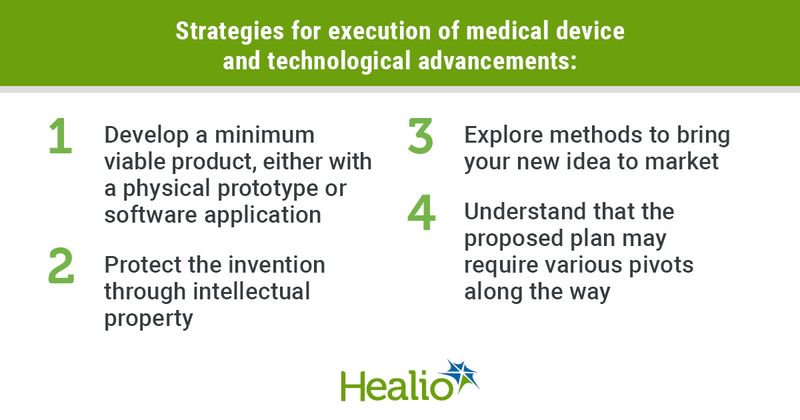Make innovation your brand: Disruption strategies for young physicians
Medicine is a dynamic profession and physicians are at the forefront of health care innovation, consistently pushing boundaries of patient care and driving both industry and practice patterns forward.
Despite being frontline caregivers and end users of medical technology, many physicians have a common misconception that innovation only takes place in the research lab or industry sponsored design studio with key opinion leader focus groups. The truth is, innovation in health care, like in other professions, can come from anywhere, and the young minds of newly minted physicians are especially primed for seeing ideas due to their uncanny ability to see the world differently.

In this column, we will present several strategies young physicians can use to inspire disruption, while also providing some tips for optimizing execution—the critical component for all good ideas.
Mindset of an innovator


As physicians progress through residency, fellowship and, ultimately, a high-powered clinical career, the success that they experience can sometimes be a hindrance to innovative ideas. Shawn Kanungo, a millennial innovation expert and author of The Bold Ones: Innovate and Disrupt to Become Truly Indispensable, describes how past successes amongst professionals in any industry frequently leads to an overreliance on previous practice patterns, which often leads to complacency in innovation. As professionals progress in their career, past successes define their identity, further hindering their innovative spirit. Understanding this concept may help you maintain a rookie mindset to come up with fresh ideas that usually are the most groundbreaking.
Identify a problem
The first step in innovating is to identify a problem that needs solving. It could be a common issue that you’ve noticed in practice or a broader problem within the industry. Peter Thiel, serial founder and entrepreneur, writes in his groundbreaking book, Zero to One: Notes on Startups, or How to Build the Future, that “the best projects are likely to be overlooked, not trumpeted by a crowd, the best problems to work on are often the ones nobody else even tries to solve.” Once you’ve identified a problem, brainstorm ideas on how to solve it. During both processes, it is important to keep a journal, either with a pen and paper or digitally, so that you can jot down quick notes in the moment as ideas arise in your head. By committing your ideas to writing, you unleash your mind’s ability to self-marinate in its own creativity to come up with truly novel concepts.
Why execution matters
As important as good ideas are, they aren’t enough for disruption. The history books are full of stories where a clever surgeon sketched out a game-changing implant design, surgical technique or research finding, only to later complain that someone else acted on their ideas and got fame, wealth or some other accolade. To truly be a disruptor, it is important to understand that all ideas are just thoughts without action and execution. Honing your ability to effectively and efficiently execute on the moments of brilliance you experience is one of the most powerful things you can do in your professional life. Below are a few strategies for execution of both medical device and digital technological advancements.
Develop a minimum viable product
Building a minimum viable product, either with a physical prototype or software application, is a good way to test the feasibility of your application and better understand its breakthrough potential. Be sure to keep the costs small as the goal at this initial stage is to visualize feasibility and identify strengths, weaknesses, opportunities and threats.
Protect your idea
If you believe in your innovation, it is important to try to protect your invention through intellectual property or some other mechanism. Provisional patents are low-cost filings with the U.S. Patent and Trademark Office that provide inventors a 12-month grace period to test their ideas and prepare a more formal patent application.
Create a go-to-market strategy
Once you feel more confident about your innovation, both from a practical standpoint and an intellectual property perspective (if applicable), start exploring methods to bring your new idea to market. Strategies could include licensing your product to a large original equipment manufacturer (OEM) like Stryker, Johnson & Johnson or Medtronic; strategic partnerships with OEMs; sale of your company or developing a full-on business. Be sure to seek professional guidance and pursue the pathway that best suits you. Finally, understand that your proposed plan likely will require various pivots along the way.
Conclusion
Innovation is not easy, but with determination, creativity and hard work, physicians can make a real impact on the industry. As the late Steve Jobs once said, “Life can be much broader, once you discover one simple fact, and that is that everything around you that you call life was made up by people that were no smarter than you.” Physicians, particularly younger ones, are especially primed to see innovative ideas sooner than others due to their rookie mindset and position at the forefront of health care innovation. Developing a disruption mindset and understanding the mechanics of execution can empower young physicians to bring about transformative change in the 21st century.
Reference:
Wealth Planning for the Modern Physician and Wealth Management Made Simple are available free in print or by ebook download by texting HEALIO to 844-418-1212 or at www.ojmbookstore.com. Enter code HEALIO at checkout.
For more information:
Sanjeev Bhatia, MD, is an orthopedic sports medicine surgeon practicing at Northwestern Medicine in Warrenville, Illinois. He can be reached at sanjeevbhatia1@gmail.com or @DrBhatiaOrtho. David B. Mandell, JD, MBA, is an attorney and founder of the wealth management firm OJM Group www.ojmgroup.com. He can be reached at 877-656-4362 or mandell@ojmgroup.com.

